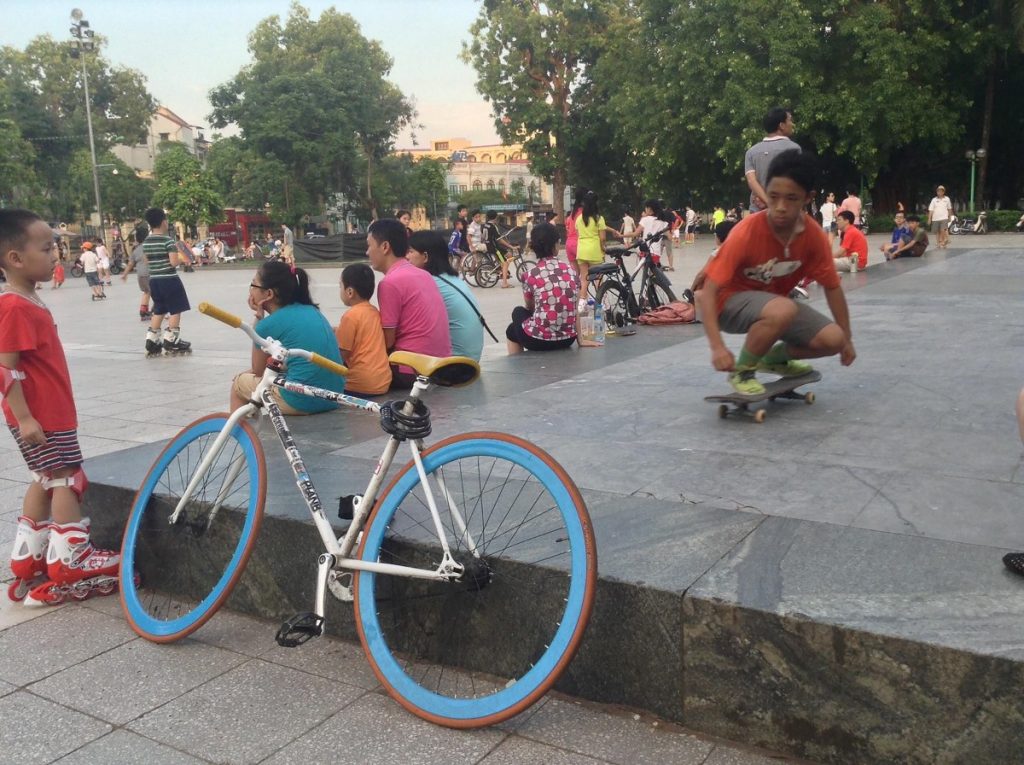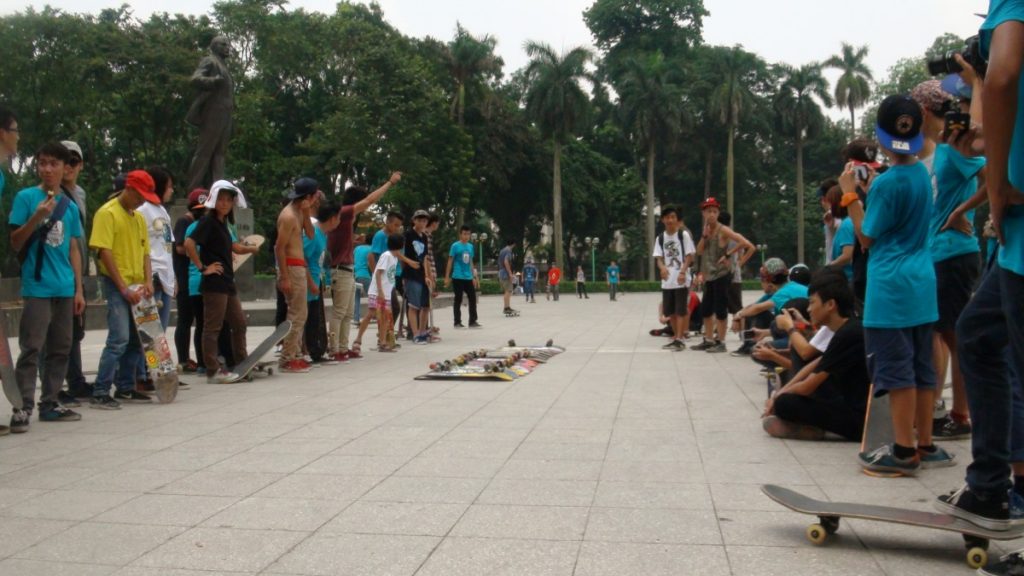Memo #385
By: Stephanie Geertman – geertman.stephanie [at] gmail.com
What can skateboarders and traceurs in Vietnam tell us about new forms of social practice?
Skateboarders riding along the base of a statue of Vladimir Lenin in a public park and traceurs climbing and jumping over walls in the newest middle-class communities flanking the city have become a familiar sight in the Vietnamese capital of Hanoi. While Vietnam continues to integrate into the world economy and culture, the country’s younger digitally connected generation is engaging in lifestyles resembling those in other global cities.
The changes initiated in urban public spatial practice by these Hanoi youths involves much more than just young people encroaching on urban space. Whereas cities are often understood as being strategically planned from the higher-levels by municipal governments and government appointed experts, these Vietnamese youths provide an example of a different form of socio-political engagement – innovation from everyday practice. Through informal networks they develop tactics of gradual appropriation, non-confrontation, and foster positive perceptions of their activities. The success of their practices has resulted in the normalization of the presence of skateboarders and traceurs in the public spaces of the city.
To be sure, Vietnam has experienced dramatic socio-economic changes during the past three decades under the reforms known as đổi mới. Nevertheless, lifestyle sports, colloquially referred to as “street arts” (nghệ thuật đường phố) faced many difficulties in gaining acceptance throughout the 1990s and the 2000s. Even within the same city of Hanoi, in older spaces such as Lenin Square, local state authorities curtailed the youths’ street activities, while in newer urban spaces such as 34T Plaza, the skateboarders and traceurs faced attempts to ban their activities from residents of the area.
However, through their everyday, non-confrontational spatial practices, such as dialoguing with security guards or practicing at times of the day when they were less liable to interact with residents, these youths circumvented constraints, leading to gradual transformations in the socio-political urban landscape in Hanoi. While this social practice is particularly striking in post-socialist Vietnam, they are not unique to Hanoi. Just as the clothing styles and the tricks in Hanoi are comparable to those of their peers in New York or Tokyo. Perhaps such innovation from the ground level in global cities may lead to more sustainable urban worlds than those envisioned and constructed by the urban leaders and planners.
About the Author:
Stephanie Geertman is an independent researcher on urban Vietnam, studying the everyday politics of urban space appropriation as it concerns the tactics of the informal housing sector (PhD, TU Eindhoven, 2007), youth (post-doctoral fellow, INRS Montreal, 2013–2015), and the creative sector (since 2015).

Skateboarding on the base of the statue of Vladimir Lenin, June 2015. (Source: Stephanie Geertman)

Skateboarding competition at Lenin Square, June 2013. (Source: Alice Miquet)
Links
- Geertman, Stephanie; Labbé, Danielle; Boudreau, Julie-Anne; Jacques, Olivier, “Youth-Driven Tactics of Public Space Appropriation in Hanoi: The Case of Skateboarding and Parkour,” Pacific Affairs 89, no. 3 (2016): 591-611.
- Asef Bayat. Life as Politics: How Ordinary People Change the Middle East. Stanford: Stanford University Press, 2010.
- Benedict Kerkvliet, The Power of Everyday Politics: How Vietnamese Peasants Transformed National Policy. New York: Cornell University Press, 2005.
- Herrara, Linda, “Youth and Citizenship in the Digital Age: A View from Egypt,” Harvard Educational Review 82, no.3 (2012): 333-352.
- Michel De Certeau. The Practice of Everyday Life, translated by Steven Rendall. Berkeley, Los Angeles, London: University of California Press, 1984.
- Christina Schwenkel, “Youth Culture and Fading Memories of War in Hanoi, Vietnam.” In Everyday Life in Southeast Asia, edited by Kathleen M. Adams and Kathleen Gillogly, 127-136. Bloomington: Indiana University Press, 2011.
- Lisa Drummond and Thi Lien Nguyen, “Uses and Understanding of Public Space Among Young People in Hanoi, Vietnam”. In The Politics of Civic Space in Asia: Building Urban Communities, edited by Amrita Danière and Michael Douglass, 175-196. London: Routledge, 2008.
If you found this memo interesting, you may also want to keep an eye out for another upcoming publication by Stephanie Geertman on youth and public space in Hanoi in the next issue of City and Society:
-
Geertman, Stephanie and Julie-Anne Boudreau. Forthcoming. ““Life as Art”: Emerging youth networks in Hanoi and the Tree Hug Movement.” City and Society.
Related Memos:
See our other memos on Vietnam.